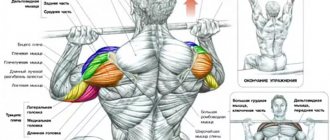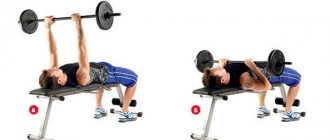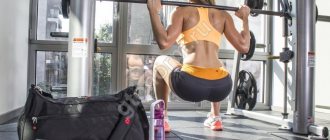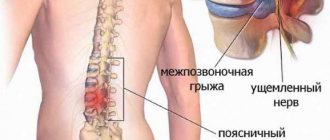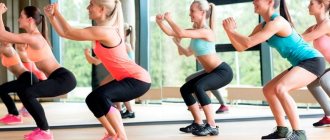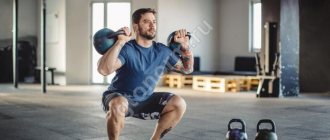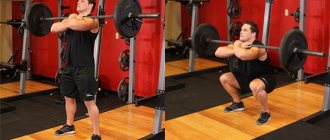05.07.2020
| 1 comment
Squats with a barbell on your shoulders are one of the best basic exercises that are aimed at developing muscle mass and leg strength. However, you should not assume that squats exclusively work the lower body.
This complex exercise involves working several muscle groups at once. After all, in order to hold a heavy bar on your back, you need to have developed core muscles that will protect your lower back from injury.
It’s not for nothing that this exercise is called a hormonal “bomb”. After all, it is what promotes the release of testosterone and growth hormone into the blood, and they, in turn, help build up the overall muscle mass of the whole body.
Benefit
- Safety.
The fact that the bar moves along the guides, eliminating the very possibility of getting hit on the crown with a projectile, reassures beginners. Yes, and you can put the barbell on the clamps at any time during the exercise, simply by turning the bar with the force of your hands.
- High level of insulation.
Due to the fact that the machine is equipped with guides, we do not need to stabilize the barbell with additional muscles (stabilizers). Therefore, it is easier for us to work the target muscle.
- Explosive reps.
In our body, muscle fibers are divided into two types: fast muscle fibers (white) and slow muscle fibers (red). This division is not accidental; it is done so that movements of different severity can be performed. In practice, fast-twitch muscle fibers (FMF) do the heavy work, and slow-twitch muscle fibers (SMF) do the light work.
The most effective training is using two types of fibers. This type of training is called pumping .
Traditionally, pumping refers to performing an exercise for a large number of repetitions (provided that the muscle is previously tired with heavy, basic exercises), thus we fill the muscles with blood (“inflating” it), provided that the rest between approaches is very short. It is due to this that more blood enters the muscle than it can pump out, so the muscles swell and become huge. This feeling cannot be confused with something else.
Using this explosive repetition technique works well with the Smith Machine because... When pumping in squats with free weight, the risk of injury increases critically.
- Performing unilateral (one arm or leg) exercises .
- The ability to quickly master all the basic exercises and build a muscle frame and then move on to free weights.
An article on how to punch the gluteal muscle is here .
Benefits of Exercise
- Basic exercises that involve several muscle groups at once contribute to the release of hormones important for gaining muscle mass: testosterone and growth hormone. The weight of the apparatus should be such that the number of repetitions varies from 8 to 15. It is this number of repetitions that is optimal for muscle hypertrophy;
- Squats with a barbell are a very energy-intensive strength exercise, which, together with a properly selected diet, helps reduce the percentage of body fat in the athlete’s body;
- Squats help strengthen the core muscles, ligaments and joints, thereby reducing the risk of injury;
- Increasing running speed at sprint distances (800m, 400m, 200m, 100m, 60m);
- Thanks to the squat, the overall endurance and strength of the whole body increases, as well as the flexibility and coordination of the body improves;
- For girls, an additional bonus is a beautiful, toned butt.
What muscles work
- targeted (main) – quadriceps femoris muscle;
- synergists (assisting) – gluteus maximus, adductor magnus, soleus muscles;
- dynamic stabilizers – muscles of the back of the thigh, gastrocnemius;
- stabilizers – spinal extensors;
- antagonists stabilizers – rectus/oblique abdominal muscles.
Good morning for gorgeous buttocks: bending over with a barbell on your shoulders
Decide on squat depth
A partial amplitude squat does not fully engage the entire array of thigh muscles, but, again, it loads the knee joint.
Squat until parallel to the floor. This will ensure maximum activation of the quadriceps.
Going just below parallel will add stress to your glutes and hamstrings. It is not necessary to squat directly to the floor unless you are planning to do powerlifting.
Don't forget about the position of your legs.
A narrower, shoulder-width stance works the quadriceps more, while placing the legs a little wider will actively engage the inner, hamstrings, and glutes.
The important point is that if you really want to increase strength in the squat, then the second option is more suitable.
The amplitude with wide stance of the legs is smaller, and all muscles evenly distribute the load among themselves. Therefore, it helps to squat with more weight.
Execution technique
The trajectory of movement is initially set by the simulator, but, of course, the exercise has some nuances.
- Go to the Smith machine, set the desired weight and step into the machine, placing the bar on the bottom of the trapezius (slightly below the neck).
Using a slightly wider than shoulder-width grip, unlock the machine by releasing the weight from the hinges and taking a small step forward. Bring your shoulder blades together, position your legs slightly wider than your shoulders (spread your toes slightly to the sides), straighten your back (statically tighten the rectus abdominis muscle, the so-called “abs” ), and direct your gaze forward.
- Inhale and begin to slowly lower the bar and bend your knees. Don't slouch your back. Lower yourself to an angle of 90 degrees (or slightly lower), while watching your knees, they should not protrude too far beyond the plane of your feet. You need to go down with the weight slowly, controlling the weight of the bar at each point.
In fact, if you don't squat to at least parallel, your glutes don't work much. Ideally, you should strive to squat as deep as possible, almost with your butt to the floor, BUT!!! This is strictly prohibited in Smith . At all. Why? Read below.
- Having reached the bottom point, begin to rise up, pushing off the floor with your heels and straightening your legs. Return to the starting position, exhaling with effort. Repeat the specified number of times.
Dream butt: glute swings and Bulgarian lunges on one leg .
We pump up the muscles involved in movement
Developed abs will help stabilize the position of the body during squats.
Strong abdominal and core muscles will relieve tension from the spine. They perform the function of a kind of corset, tightly holding the body as a single structure.
Focus on static abdominal exercises, such as the plank and its variations. Very good for developing abdominal muscle strength and curling with a roller on the floor.
Don't forget about the strength of your back muscles.
For example, powerlifters like to lower the barbell to the very bottom of their traps or hold it on their rear delts when squatting.
Strong lats, especially the middle, upper back, and lower back, will help secure your squat position. A wider grip on the bar is used to better stabilize the body.
If the goal is to make the squat more powerful, then be sure to include in the program exercises that develop all the muscles involved in the work:
- Leg Press and Leg Extension for Quadriceps
- Standing calf raises for calves
- Leg curls and deadlifts for hamstrings
- Glute bridge with barbell
- Hyperextension, bending with a barbell on the shoulders while standing and sitting to develop back extensors
- Bent-over barbell rows and lat pulldowns for the back
- Shrugs for trapezius
Options
In theory, by changing the position of the legs, you can change the emphasis of the load on the necessary muscles.
Frontal
Front squats (or hack squats) are a more relevant technique for men. When squatting with a narrow leg stance, the load is shifted to the outer part of the quadriceps (lateral head).
Front squat technique in a simulator for men:
Go to the Smith machine and, with your arms crossed, mark the exercise bar on them. Elbows should be strictly parallel to the ground. The feet are under the shoulders, and the toes are turned 30-45 degrees. Tighten your abdominal muscles and only after you feel confident enough begin the movement. Keep your back straight and slowly lower yourself until your thighs are parallel to the ground. Push through your heels and return to the starting position.
The working weight when performing front squats is less than in classic ones!
Sumo
When wide , the load is greater on the inner surface of the thigh (adductor muscles).
Plie
With the legs brought forward onto the buttocks
For girls: how to squat with an emphasis on the buttocks? Usually it is this technique of execution that is meant by the squat for girls in the Smith machine. To specifically work the gluteal muscles, your legs need to be placed a little further and your feet hip-width apart. This is the most dangerous and most unphysiological option for performing a squat in a simulator for women; it is difficult to imagine such a perdimonocle in life: sit down while moving your legs forward. In addition, with any positioning of your legs, you “block” your joints in a straight path, which never happens in life.
This is just some special form of perversion. Doing plie in Smith is very inconvenient and practically impossible. We do not recommend this option to you. Read: How to effectively pump up Madame Sizhu: plie and sumo squats
Dream Butt: Romanian Deadlift and Glute Bridge .
Tips for implementation
- To avoid vertebral injury, keep your lower back slightly arched throughout the entire period of the movement;
- Heels should not lift off the floor, otherwise there is a risk of losing balance and getting serious bruises;
- To improve a stable position when performing squats, it is necessary to keep the abdominal muscles tense throughout the entire approach;
- When doing squats, use weights or shoes with flat, hard soles, and throw running shoes with a soft, springy base to the side. The springy base gives an unstable position during a squat;
- Watch your shoulders, they should not go beyond the vertical line of your knees;
- The wider the stance of the feet, the more the back of the thigh is involved in the work. To target the quadriceps, your feet should be shoulder-width apart;
- Warm up thoroughly before you begin the squat;
- In the first month, it is necessary to study and practice the technique in detail, so you should not chase heavy weights from the first steps;
- For additional reliability, it is advisable to perform squats together with a trainer or gym partner;
- Do not try to put anything under your heels, this will put additional stress on the knee joints and lead to their wear;
- If after previous training there is pain in the back or joints, you should temporarily give up squats;
- If you want to strengthen your core muscles, you should not wear a waist belt. It is only needed for low rep squats with heavy weights.
With free weights or in the car?
Is there any harm from squatting in Smith? There are quite a few!
- Even based on the advantages described above, the motto of exercises (especially squats) in the Smith machine emerges by itself: goodbye, stabilizers ! So what, you say. And we will answer: if you exercise on such machines, the stabilizers will lag behind the main muscle group in growth.
- Questionable effectiveness.
Research published in the journal Strength and Condition Research (2013) tells us that muscle EMG activity during the free weight squat is 43% higher than the Smith squat. Electromyographic activity was 34%, 26%, and 49% higher in the gastrocnemius, biceps femoris, and vastus muscles.
Conclusion : why settle for a smaller effect?
- Rod movement trajectory.
Smith can be good at the beginning of your journey , when you are still learning. When you don't have to concentrate on maintaining your balance, you can pay more attention to other important nuances like the position of your feet, the direction of your knees, your chest raised, your shoulder blades pulled together, and holding your breath in a timely manner. And in principle, you should first pump up your back and achieve a certain tone of the body muscles before diving under the barbell.
But always remember: Smith is a crutch and you don’t need to walk with it all your life, if you have healthy limbs. Over time, when the working weights become larger, the straight trajectory of the bar movement in the Smith machine will put the knee and shoulder joints, as well as the lower back, in an unnatural position, no matter what you do - presses, rows (although it is a complete perversion to do these exercises in the Smith machine) or squats. This will be especially dangerous in the squat for girls for the buttocks.
Additionally, Smith machine squats develop poor squatting technique , which can lead to serious injury when transitioning from this exercise to a barbell squat. To learn how to squat to develop your glutes, read “The Ideal Squat for Your Glutes and Firm Butt”
- The risk of injury is increased.
The first blow is taken by the spine, because an axial load is created on it. If you have scoliosis, osteochondrosis, etc., perform it only with the permission of a doctor! But you can overdo it so much that a completely healthy spine becomes not very healthy.
Two main rules:
- ⛔You can’t squat, deliberately bringing your knees behind your socks (to specifically put a load on the buttocks)!
⛔You can’t squat “to the floor”!
- Lack of real strength progress.
The Smith machine gives you false sense of strength gain, and that's because it does all the stabilizing work for you. During the exercise, the power rack helps you by relieving the load on the small muscles of the stabilizers. As a result, they are excluded from work and are not pumped (stagnant). You can supposedly increase your performance (working weights), but in fact, when you switch to a squat with free weight, this progress will be insignificant or there will be no progress at all.
In these cases, the load is distributed unevenly and hits the kneecaps . The danger is that this is a time bomb that will make itself felt, if not today, then the day after tomorrow for sure.
When working with heavy weights, it is almost impossible . And most often the knees come into play again: helping ourselves to lift the weight, we often turn our knees inward. And this is the certain death of your joint.
The knees always “look” in the same direction as the socks. Squat with your legs parallel – your knees are parallel. Turn your toes outward - your knees look strictly apart.
Pointless and merciless exercises of fitness girls: kneeling squats (on knees)
Iron Health
Progress in muscle growth implies progress in the athlete's strength. This means that increasing the working weight in the exercises will have a positive effect on the growth of muscle mass, since the overall intensity of the load has also increased. Well, what if the working weights are stuck in one place and don’t want to grow further? For this purpose, a special strength program is required. In this article we will analyze this and answer a specific question - how to increase the working weight in squats with a barbell?
Factors that improve squat performance
To build the correct training scheme, it is necessary to understand what our performance in squats with a barbell depends on. And it depends on the following main factors:
- Strength indicators of the main working muscles - quadriceps;
- Strength indicators of auxiliary muscles - gluteal muscles, hip adductors, hamstrings, calves, back muscles, etc.;
- Readiness of the nervous system for heavy strength work.
In this list, I do not consider the correct execution technique, since this is a fundamental factor, without which it is simply stupid to think about any increase in working weight. I assume that you have already mastered the technique of performing squats with a barbell.
Thus, by influencing the above factors, we will influence the performance of barbell squats. All that remains is to create the correct program that would take into account everything stated above.
Program for increasing working weight in squats
The training routine will look like this: Weeks #1, #3, #5, #7
| Exercises | Approaches | Repetitions | Rest between sets |
| Squats | 3 | 6 | 3 min |
| Lunges with dumbbells | 3 | 8 | 3 min |
| Lying leg curl | 3 | 12 | 2.5 min |
| Hyperextensions with weights | 3 | 12 | 2.5 min |
Weeks #2, #4, #6
| Exercises | Approaches | Repetitions | Rest between sets |
| Squats | 3 | 4 | 3 min |
| Lunges with dumbbells | 3 | 8 | 3 min |
| Lying leg curl | 3 | 12 | 2.5 min |
| Hyperextensions with weights | 3 | 12 | 2.5 min |
How to run the program?
- Accurately calculate your working weight for 6 repetitions, this will be the starting point for performing 6 repetitions of squats in the first week;
- Every second week (when we have to perform 4 repetitions) we increase the working weight in squats with a barbell by 2.5 kg;
- The complex is performed once a week - either separately from other muscles, or in a split pattern with a complex for deltoids or triceps;
- The complex does not tolerate skipping classes, since in this case you will not be able to add working weight and perform the required number of repetitions;
- The total duration of the complex is 7 weeks;
- After training, be sure to take creatine + protein.
- This complex is guaranteed to provide an increase in working weights in squats - a total of no less than +7.5 kg at the end of 7 weeks.
Example program execution
Let’s imagine that our working weight in squats with a barbell is 100 kg for 6 reps.
- Week 1 – we perform 3 sets of 6 reps with a weight of 100 kg
- Week 2 – we perform 3 sets of 4 reps with a weight of 102.5 kg (+2.5 kg)
- Week 3 – we perform 3 sets of 6 reps with a weight of 102.5 kg
- Week 4 – we perform 3 sets of 4 reps with a weight of 105 kg (+2.5 kg)
- Week 5 – we perform 3 sets of 6 reps with a weight of 105 kg
- Week 6 – we perform 3 sets of 4 reps with a weight of 107.5 kg (+2.5 kg)
- Week 7 – we perform 3 sets of 6 reps with a weight of 107.5 kg
Thus, over 7 weeks of the complex, we increased our working weight in squats by 7.5 kg. Now it is not 100 kg for 6 reps, but 107.5 kg for 6 reps. Happy training!
Pancakes under the heels
You probably paid attention to some super mega online trainers and part-time fitness bikini trainers - how they place small discs (“pancakes”) weighing up to 1.25-2.5 kg under the heels before squats. Beginners often copy such habits of their more “wise and sophisticated” owners of gorgeous asses, without even asking themselves why this is necessary. It is believed that this is better, just better, without details.
“The exercise is more effective, it seems that the gluteal muscles feel better, but I don’t know…”
It seems very similar to the opinion that small, frequent meals speed up metabolism



